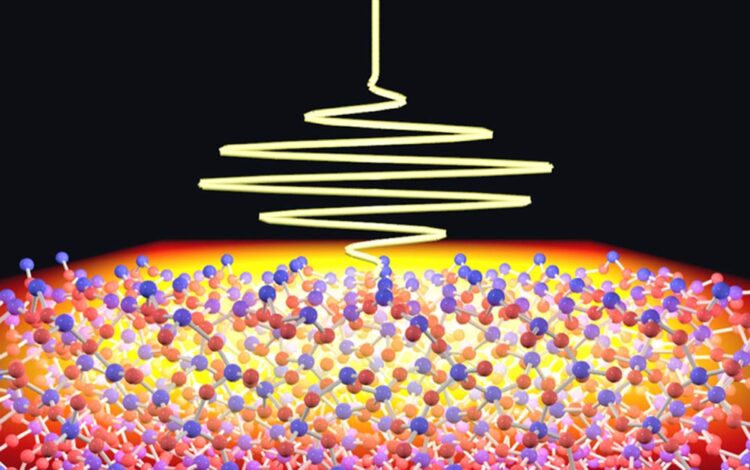Light–matter interactions simulated on the world’s fastest supercomputer

Researchers led by the University of Tsukuba developed a computational approach for simulating interactions between matter and light at the atomic scale. The team tested their method by modeling light–matter interactions in a thin film of amorphous silicon dioxide, composed of more than 10,000 atoms, using the world’s fastest supercomputer, Fugaku. The proposed approach is highly efficient and could be used to study a wide range of phenomena in nanoscale optics and photonics.
Credit: University of Tsukuba
Researchers led by the University of Tsukuba present an improved way to model interactions between matter and light at the atomic scale.
Light–matter interactions form the basis of many important technologies, including lasers, light-emitting diodes (LEDs), and atomic clocks. However, usual computational approaches for modeling such interactions have limited usefulness and capability. Now, researchers from Japan have developed a technique that overcomes these limitations.
In a study published this month in The International Journal of High Performance Computing Applications, a research team led by the University of Tsukuba describes a highly efficient method for simulating light–matter interactions at the atomic scale.
What makes these interactions so difficult to simulate? One reason is that phenomena associated with the interactions encompass many areas of physics, involving both the propagation of light waves and the dynamics of electrons and ions in matter. Another reason is that such phenomena can cover a wide range of length and time scales.
Given the multiphysics and multiscale nature of the problem, light–matter interactions are typically modeled using two separate computational methods. The first is electromagnetic analysis, whereby the electromagnetic fields of the light are studied; the second is a quantum-mechanical calculation of the optical properties of the matter. But these methods assume that the electromagnetic fields are weak and that there is a difference in the length scale.
“Our approach provides a unified and improved way to simulate light–matter interactions,” says senior author of the study Professor Kazuhiro Yabana. “We achieve this feat by simultaneously solving three key physics equations: the Maxwell equation for the electromagnetic fields, the time-dependent Kohn–Sham equation for the electrons, and the Newton equation for the ions.”
The researchers implemented the method in their in-house software SALMON (Scalable Ab initio Light–Matter simulator for Optics and Nanoscience), and they thoroughly optimized the simulation computer code to maximize its performance. They then tested the code by modeling light–matter interactions in a thin film of amorphous silicon dioxide, composed of more than 10,000 atoms. This simulation was carried out using almost 28,000 nodes of the fastest supercomputer in the world, Fugaku, at the RIKEN Center for Computational Science in Kobe, Japan.
“We found that our code is extremely efficient, achieving the goal of one second per time step of the calculation that is needed for practical applications,” says Professor Yabana. “The performance is close to its maximum possible value, set by the bandwidth of the computer memory, and the code has the desirable property of excellent weak scalability.”
Although the team simulated light–matter interactions in a thin film in this work, their approach could be used to explore many phenomena in nanoscale optics and photonics.
The article, “Large-scale ab initio simulation of light-matter interaction at the atomic scale in Fugaku,” was published in The International Journal of High Performance Computing Applications at DOI: https://doi.org/10.1177/10943420211065723
Funding: This research was supported by MEXT as a priority issue (theme 7) to be tackled using the Post-K Computer; by JST-CREST (grant number JP-MJCR16N5); and by the MEXT Quantum Leap Flagship Program (MEXT Q-LEAP, grant number JPMXS0118068681).
Media Contact
Naoko Yamashina
University of Tsukuba
kohositu@un.tsukuba.ac.jp
All latest news from the category: Information Technology
Here you can find a summary of innovations in the fields of information and data processing and up-to-date developments on IT equipment and hardware.
This area covers topics such as IT services, IT architectures, IT management and telecommunications.
Newest articles

Properties of new materials for microchips
… can now be measured well. Reseachers of Delft University of Technology demonstrated measuring performance properties of ultrathin silicon membranes. Making ever smaller and more powerful chips requires new ultrathin…

Floating solar’s potential
… to support sustainable development by addressing climate, water, and energy goals holistically. A new study published this week in Nature Energy raises the potential for floating solar photovoltaics (FPV)…

Skyrmions move at record speeds
… a step towards the computing of the future. An international research team led by scientists from the CNRS1 has discovered that the magnetic nanobubbles2 known as skyrmions can be…





















